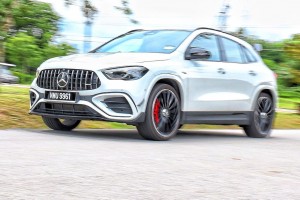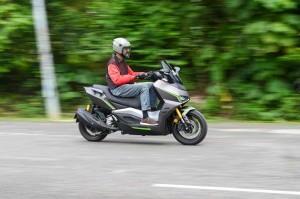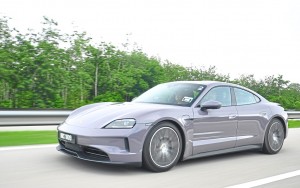BOLOGNA: Lamborghini has unveiled the first details of the first HPEV (High Performance Electrified Vehicle) hybrid super sports car, codenamed LB744, which will make its debut shortly in the year that Lamborghini celebrates its 60th anniversary.
With the LB744, Lamborghini has established a new benchmark in terms of performance and driving pleasure: an all-new architecture with new powertrain delivers more than 1000 CV in total, combining the power of a brand new 12-cylinder internal combustion engine with three electric motors and a ground-breaking double clutch gearbox that makes its debut on the 12-cylinder Lamborghini.
The car showcases an unprecedented layout: the naturally-aspirated 6.5-litre V12 mid-mounted engine is complemented by three electric motors, one of which is integrated into the new double-clutch eight-speed gearbox.

This is mounted transversely and placed for the first time behind the combustion engine. In what has been the transmission tunnel since the days of the Countach, there is a lithium-ion battery instead, which powers the electric motors.
The electric motors boost power delivery at low revs and can also turn the new LB744 into a purely electric car, reducing overall CO2 emissions by 30% compared to the Aventador Ultimae.
Lamborghini has been synonymous with V12 engines since the company was founded.
The first Lamborghini model to sport this characteristic engine was the iconic 350GT launched in 1963. The first time that an electric motor was matched to a 12-cylinder internal combustion engine in a Lamborghini was in 2019 with the Sián, which used a 25 kW electric engine to support the previous generation of V12, storing the electrical energy in a supercapacitor.

The LB744 introduces an unprecedented hybrid architecture and a new generation of V12. The car is launched as the very first High Performance Electrified Vehicle - HPEV: a plug-in hybrid super sports car equipped with a lightweight high-power lithium ion battery, housed within the transmission tunnel in the central section of the chassis. It’s an innovative solution, designed to reduce emissions compared to the previous V12 while maximizing performance.
The new L545 engine is the lightest and most powerful 12-cylinder engine ever made by Lamborghini. In total it weighs just 218kg: 17kg less than the Aventador unit.
The LB744 features the engine rotated through 180 degrees compared to the Aventador layout. The superquadro V12 puts out 825 CV at 9250 revs per minute thanks to the redesigned distribution system that supports a maximum rev range of 9500 rpm. Specific power is 128 CV per litre, the highest output in the history of Lamborghini’s 12-cylinder engines, while maximum torque is 725 Nm at 6750 rpm.
The air intake ducts to the cylinders have been re-engineered to increase the supply of air and guarantee optimal airflow in the combustion chamber.
Particular attention has been lavished on the "soundtrack" of the new L545 to emphasize the tone of the engine, already melodious at low revs and then rising to a natural harmonious crescendo.
The LB744 retains one of Lamborghini’s strongest traditions: four-wheel drive.

As well as the internal combustion engine that provides power to the rear wheels, a pair of electric motors now make their debut on the front axle, each supplying traction to one of the front wheels. There’s also a third electric motor positioned above the eight-speed double-clutch gearbox that can supply power to the rear wheels, depending on the selected driving mode and the conditions.
The combined torque from the combustion engine and three electric motors offers performance levels that are unique even within the domain of super sports cars, with 725 Nm produced by the internal combustion engine and 350 Nm from each of the front electric motors. In total, the power unit delivers a combined maximum output of 1015 CV.
The two electric motors at the front are oil-cooled axial flux units and offer an exceptional weight-to-power ratio: 18.5 kilograms from each of the 110 kW units.
As well as providing power to the front wheels, they also have a torque vectoring function, optimising driving dynamics, and recuperating the energy produced under braking.
When in electric mode, the LB744 is front-wheel drive only to optimize energy consumption, while electric drive to the rear axle is activated on demand when needed.
The Lamborghini LB744 is equipped with a lithium-ion high specific power (4500 W/kg) battery pack situated within the central tunnel, keeping the centre of gravity as low as possible and ensuring optimal weight distribution. The battery is protected by a lower structural layer and is connected to the front electric motors, the rear electric motor, and an integrated recharging unit.

The battery is 1550mm long, 301mm high, and 240mm wide, containing pouch cells with an overall capacity of 3.8 kWh. When the charge drops down to zero it can be recharged using both ordinary domestic alternating and charging column current up to 7 kW in power, and completely recharges in just 30 minutes.
It can also be recharged under regenerative braking from the front wheels or directly from the V12 engine in just six minutes.
The new compact transmission unit was developed and designed by Lamborghini entirely in-house, and after the LB744 it will go on to equip the next generation of super sports cars.
Lamborghini developed a wet double clutch as the most efficient and performance-oriented solution, best capable of managing the 725 Nm of torque at 6750 rpm from the internal combustion engine.
The new eight-speed gearbox is positioned transversally behind the longitudinal V12 engine, to leave space in the tunnel for the lithium-ion battery that feeds the electric motors.
It’s a technical solution that’s unique in the world of high-performance cars. The layout helps to keep the car’s wheelbase contained and supports effective weight distribution for the best driving dynamics.

In the 60-year history of Lamborghini, only two other V12 cars have been equipped with a transverse rear gearbox: the Miura launched in 1966, which also adopted a mid-rear transverse engine layout; and the Essenza SCV12, a track-focused hypercar with a longitudinal engine and load-bearing transverse gearbox.
The development of an eight-speed Double Clutch Transmission (DCT) comes from the desire to create a unit that provides everything needed for sporty driving such as fast gear shifts, while the inclusion of an eighth ratio helps optimise fuel consumption and drivability while cruising.
A particular feature is the "continuous downshifting", which drops down multiple gears under braking simply by holding down the left paddle, giving the driver the feeling of total control.
Leaving aside the electrical components, the new DCT gearbox is lighter and faster in terms of shifting speed compared to the seven-speed double clutch unit that is used in the Huracán range.
The transverse layout has also allowed for a more spacious cabin interior, creating more room behind the driver and passenger to improve comfort.
The double-clutch gearbox is extremely compact; just 560mm long, 750mm wide and 580mm high. Total weight is just 193 kg, which includes a new component fundamental to the car’s hybrid architecture: the rear electric motor, with maximum power of 110kW and peak torque of 150Nm.

Located above the gearbox, this electric motor doubles as the starter motor and generator, as well as supplying energy to the front electric motors via the battery in the transmission tunnel.
In full electric mode it can also provide power to the rear wheels that, in addition to the e-motors driving the front wheels, allows zero-emission four-wheel drive.
How the system functions depends on which driving mode is engaged, thanks to an uncoupling mechanism with a dedicated synchroniser allowing the connection to the double-clutch gearbox.
When it is providing additional power to the V12 internal combustion engine, the electric motor is in P3 position, separated from the gearbox, while it moves into the P2 position to recharge the battery at low speeds and when parked, also serving a starter motor.
In the P3 position, the LB744 can become an electric four-wheel drive car, depending on the drive mode selected, continuing Lamborghini’s four-wheel drive tradition even with zero emissions.
Reverse gear is provided by the two front electric motors, although if extra momentum is needed the rear electric motor can also kick in, which activates the rear axle and wheels.
As a result, the new LB744 can drive all four wheels in zero emission mode even when reversing in low grip conditions.












